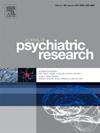Impact of cybersickness and presence on treatment satisfaction and clinical outcomes in virtual reality-based biofeedback for depression and anxiety
IF 3.7
2区 医学
Q1 PSYCHIATRY
引用次数: 0
Abstract
Virtual Reality-Biofeedback (VR-BF) has emerged as a novel digital intervention for reducing anxiety and depressive symptoms. This study aimed to assess the relationship between cybersickness, presence, treatment satisfaction, and symptom change following VR-BF. In this prospective clinical study, 80 drug-naive adults were enrolled and classified into two groups: those with subclinical depressive and anxiety symptoms (n = 40) and healthy controls (n = 40). All participants completed three sessions of a self-developed VR-BF intervention over four weeks. Clinical outcomes related to depression and anxiety symptoms were assessed using established psychological scales, along with post-intervention evaluations of presence, cybersickness, and treatment satisfaction. Higher presence was associated with greater reductions in anxiety (ΔSTAI: β = −0.24, SE = 0.06, P < 0.001), stress (ΔVAS: β = −0.37, SE = 0.13, P = 0.008), and depressive symptoms (ΔPHQ-9: β = −0.07, SE = 0.02, P = 0.008), and with greater treatment satisfaction (β = 0.07, SE = 0.01, P < 0.001). Cybersickness was inversely correlated with presence (ρ = −0.38, P < 0.001) and satisfaction (β = −0.11, SE = 0.04, P = 0.013) and was associated with smaller improvements in anxiety (ΔSTAI: β = 0.62, SE = 0.30, P = 0.044) and depressive symptoms (ΔPHQ-9: β = 0.28, SE = 0.12, P = 0.019). Female sex and older age were associated with greater clinical improvement and higher satisfaction. These findings underscore the relevance of experiential process factors in VR-BF and support further development of user-centered, tolerable, and clinically effective VR-based interventions.
在基于虚拟现实的抑郁和焦虑生物反馈中,晕机和存在对治疗满意度和临床结果的影响
虚拟现实-生物反馈(VR-BF)已经成为一种新型的数字干预,用于减少焦虑和抑郁症状。本研究旨在评估VR-BF治疗后晕机、存在感、治疗满意度和症状改变之间的关系。在这项前瞻性临床研究中,80名未接受药物治疗的成年人被分为两组:有亚临床抑郁和焦虑症状(n = 40)和健康对照组(n = 40)。所有参与者在四周内完成了三次自行开发的VR-BF干预。使用既定的心理量表评估与抑郁和焦虑症状相关的临床结果,以及干预后对存在感、晕机和治疗满意度的评估。较高的存在与焦虑程度的显著降低相关(ΔSTAI: β = - 0.24, SE = 0.06, P <;0.001)、压力(Δ脉管:β=−0.37 = 0.13,P = 0.008),和抑郁症状(Δphq - 9:β=−0.07 = 0.02,P = 0.008),和更大的治疗满意度(β= 0.07,= 0.01,P & lt;0.001)。晕屏病与在场呈负相关(ρ = - 0.38, P <;0.001)和满意度(β = - 0.11, SE = 0.04, P = 0.013),并且与焦虑(ΔSTAI: β = 0.62, SE = 0.30, P = 0.044)和抑郁症状(ΔPHQ-9: β = 0.28, SE = 0.12, P = 0.019)的较小改善相关。女性和年龄越大,临床改善越大,满意度越高。这些发现强调了VR-BF中体验过程因素的相关性,并支持进一步开发以用户为中心、可耐受且临床有效的vr干预措施。
本文章由计算机程序翻译,如有差异,请以英文原文为准。
求助全文
约1分钟内获得全文
求助全文
来源期刊

Journal of psychiatric research
医学-精神病学
CiteScore
7.30
自引率
2.10%
发文量
622
审稿时长
130 days
期刊介绍:
Founded in 1961 to report on the latest work in psychiatry and cognate disciplines, the Journal of Psychiatric Research is dedicated to innovative and timely studies of four important areas of research:
(1) clinical studies of all disciplines relating to psychiatric illness, as well as normal human behaviour, including biochemical, physiological, genetic, environmental, social, psychological and epidemiological factors;
(2) basic studies pertaining to psychiatry in such fields as neuropsychopharmacology, neuroendocrinology, electrophysiology, genetics, experimental psychology and epidemiology;
(3) the growing application of clinical laboratory techniques in psychiatry, including imagery and spectroscopy of the brain, molecular biology and computer sciences;
 求助内容:
求助内容: 应助结果提醒方式:
应助结果提醒方式:


